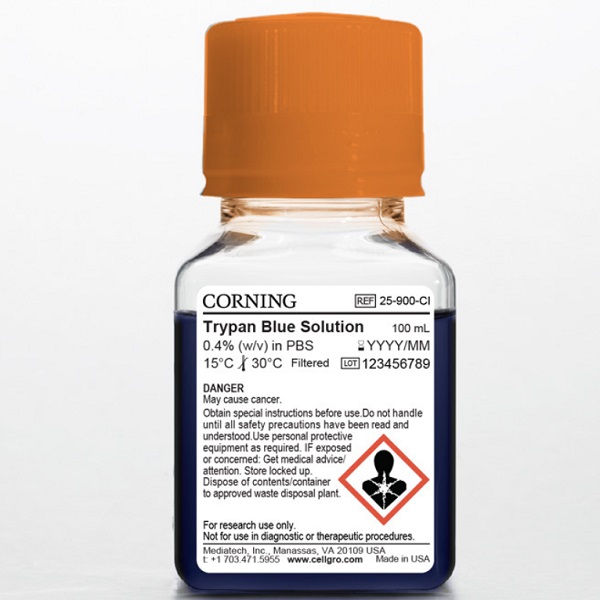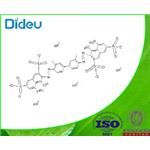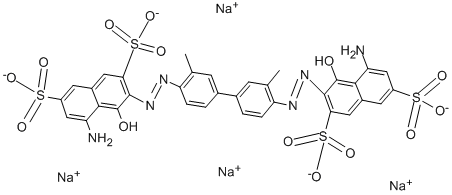Trypan Blue
- CAS No.
- 72-57-1
- Chemical Name:
- Trypan Blue
- Synonyms
- trypan;blue3b;blueemb;parkipan;CI 23850;congoblue;ncic61289;parkibleu;TRUE BLUE;benzoblue
- CBNumber:
- CB8315001
- Molecular Formula:
- C34H24N6Na4O14S4
- Molecular Weight:
- 960.81
- MDL Number:
- MFCD00003969
- MOL File:
- 72-57-1.mol
| Melting point | >300 °C (lit.) |
|---|---|
| Density | 1.007 g/mL at 20 °C |
| storage temp. | dry at room temperature |
| solubility | H2O: soluble10mg/mL |
| Colour Index | 23850 |
| form | Powder |
| color | Dark greenish-brown |
| PH | 9.8 (10g/l, H2O, 20℃) |
| Water Solubility | 10 g/L (25 ºC) |
| Merck | 14,9792 |
| BRN | 4360496 |
| Stability | Stable. Incompatible with strong oxidizing agents. |
| CAS DataBase Reference | 72-57-1(CAS DataBase Reference) |
| FDA UNII | I2ZWO3LS3M |
| Proposition 65 List | Trypan Blue (Commercial Grade) |
| IARC | 2B (Vol. 8, Sup 7) 1987 |
| EPA Substance Registry System | Trypan blue (72-57-1) |
SAFETY
Risk and Safety Statements
| Symbol(GHS) |  GHS08 |
|||||||||
|---|---|---|---|---|---|---|---|---|---|---|
| Signal word | Danger | |||||||||
| Hazard statements | H350 | |||||||||
| Precautionary statements | P201-P202-P280-P308+P313-P405-P501 | |||||||||
| Hazard Codes | T,Xi | |||||||||
| Risk Statements | 45-41-37/38-36/37/38-22 | |||||||||
| Safety Statements | 53-45-36/37/39-36-26 | |||||||||
| RIDADR | 2811 | |||||||||
| WGK Germany | 3 | |||||||||
| RTECS | QJ6475000 | |||||||||
| TSCA | Yes | |||||||||
| HS Code | 32041400 | |||||||||
| Toxicity | LD100 i.v. in rats: 300 mg/kg (Anderson) | |||||||||
| NFPA 704 |
|
Trypan Blue price More Price(32)
| Manufacturer | Product number | Product description | CAS number | Packaging | Price | Updated | Buy |
|---|---|---|---|---|---|---|---|
| Sigma-Aldrich | 302643 | Trypan Blue Dye content 60 % | 72-57-1 | 25g | $108 | 2024-03-01 | Buy |
| Sigma-Aldrich | 302643 | Trypan Blue Dye content 60 % | 72-57-1 | 100g | $364 | 2024-03-01 | Buy |
| Sigma-Aldrich | 1.11732 | Trypan blue (C.I. 23850) formicroscopy | 72-57-1 | 25g | $178 | 2022-05-15 | Buy |
| TCI Chemical | T0556 | Direct Blue 14 | 72-57-1 | 25g | $39 | 2024-03-01 | Buy |
| Alfa Aesar | A18600 | Trypan Blue, dye content >60% | 72-57-1 | 25g | $37.4 | 2024-03-01 | Buy |
Trypan Blue Chemical Properties,Uses,Production
Chemical Properties
Trypan Blue is a dark Blue crystalline solid or powder that dissolves in water to form a blue solution. It's slightly soluble in soluble fiber yarn and doesn't dissolve in other organic solvents. When mixed with concentrated sulfuric acid, it turns dark greenish-blue, and when diluted, it becomes reddish-blue. With concentrated nitric acid, it creates a brownish-gray solution. In a 10% sulfuric acid solution, its aqueous solution turns red, while with sodium hydroxide, it becomes reddish-purple.
Uses
Trypan Blue is an azo based, hydrophilic, tetrasulfonated blue acid dye widely utilized for assessing cell viability. As an easy method to determining the viability of cells, Trypan Blue will stain dead cells with permeable membranes blue, while the dye is excluded by most living cells and their intact membranes thereby allowing visual determination of living versus dead cells. Although Trypan Blue is predominately used for assessing cell viability of cultured cells, other applications for this dye have been reported. In rat abdominal organ slices Trypan Blue has been utilized to determine cell viability as well as islet cell cluster cell viability from caprine pancreatic samples. Dyes and metabolites.
Uses
Trypan blue has been used as a dye in trypan blue exclusion assay/cell viability assay to detect dead cells.
Definition
ChEBI: Trypan blue is an organosulfonate salt that is the tetrasodium salt of 3,3'-[(3,3'-dimethylbiphenyl-4,4'-diyl)didiazene-2,1-diyl]bis(5-amino-4-hydroxynaphthalene-2,7-disulfonic acid). It has a role as a histological dye, a fluorochrome and a carcinogenic agent. It is an organosulfonate salt and an organic sodium salt. It contains a trypan blue(4-).
Preparation
3,3′-Dimethylbenzidine double nitriding, in alkaline conditions and 4-Amino-5-hydroxynaphthalene-2,7-disulfonic acid(2 Moore) coupled.
General Description
Bluish-gray to dark blue powder.
Air & Water Reactions
Azo dyes can be explosive when suspended in air at specific concentrations. Slightly soluble in water.
Reactivity Profile
Direct Blue 14 is an azo compound. Azo, diazo, azido compounds can detonate. This applies in particular to organic azides that have been sensitized by the addition of metal salts or strong acids. Toxic gases are formed by mixing materials of this class with acids, aldehydes, amides, carbamates, cyanides, inorganic fluorides, halogenated organics, isocyanates, ketones, metals, nitrides, peroxides, phenols, epoxides, acyl halides, and strong oxidizing or reducing agents. Flammable gases are formed by mixing materials in this group with alkali metals. Explosive combination can occur with strong oxidizing agents, metal salts, peroxides, and sulfides. Direct Blue 14 is incompatible with strong oxidizing agents and strong acids.
Health Hazard
ACUTE/CHRONIC HAZARDS: Direct Blue 14 may cause irritation and may be absorbed through the skin. It is a positive animal carcinogen. When heated to decomposition Direct Blue 14 emits very toxic fumes of nitrogen oxides, sulfur oxides, carbon monoxide and carbon dioxide.
Fire Hazard
Flash point data for Direct Blue 14 are not available; however, Direct Blue 14 is probably combustible.
Biochem/physiol Actions
Trypan Blue is excluded by most living cells, but can be taken into phagocytes and certain other cells.
Safety Profile
Suspected carcinogen with experimental carcinogenic, neoplastigenic, and tumorigenic data. Poison by intraperitoneal, intravenous, and subcutaneous routes. Experimental teratogenic and reproductive effects. Mutation data reported. When heated to decomposition it emits very toxic fumes of NOx NazO, and SOx
Potential Exposure
Used in dyeing textiles; leather and paper; as a biological stain.
Shipping
UN2811 Toxic solids, organic, n.o.s., Hazard Class: 6.1; Labels: 6.1-Poisonous materials, Technical Name Required. UN3143 dyes, solid, toxic, n.o.s. or dye intermediates, solid, toxic, n.o.s., Hazard Class: 6.1; Labels: 6.1-Poisonous materials, Technical Name Required.
Staining Procedures
A 0.01-0.2% aqueous solution is used for root staining. The method is often used for investigation of mycorrhizas. Suitable for whole mounts as well as sections. Also used as a stain for vitality, as living cells generally remain unstained.
Properties and Applications
blue. Blue gray powder. Soluble in water for blue, slightly soluble in soluble fiber element, insoluble in other organic solvents. The strong sulfuric acid in dark green light for blue, diluted into a red light blue; In the light of nitric acid for palm gray solution. The dye solution to join a red sulfuric acid 10% change; Add thick sodium hydroxide solution for red light purple.
| Standard | Acid Resistance | Alkali Resistance | Light Fastness | Soaping | Water | ||
| Fading | Stain | Fading | Stain | ||||
| ISO | 4-5 | 4 | 1-2 | 2 | 2 | ||
| AATCC | 5 | 2 | 1-2 | 2 | 1 | ||
Incompatibilities
Dust may form explosive mixture with air. Trypan Blue is incompatible with strong oxidizing agents. Incompatible with oxidizers (chlorates, nitrates, peroxides, permanganates, perchlorates, chlorine, bromine, fluorine, etc.); contact may cause fires or explosions. Keep away from alkaline materials, strong bases, strong acids, oxoacids, epoxides. Azo compounds can detonate. This applies in particular to organic azides that have been sensitized by the addition of metal salts or strong acids. Toxic gases are formed by mixing materials of this class with acids, aldehydes, amides, carbamates, cyanides, inorganic fluorides, halogenated organics, isocyanates, ketones, metals, nitrides, peroxides, phenols, epoxides, acylhalides, and strong oxidizing or reducing agents. Flammable gases are formed by mixing materials in this group with alkali metals. Explosive combinations can occur with strong oxidizing agents, metal salts, peroxides, and sulfides. Trypan Blue is sensitive to prolonged exposure to heat.
Waste Disposal
Consult with environmental regulatory agencies for guidance on acceptable disposal practices. Generators of waste containing this contaminant (≥100 kg/mo) must conform with EPA regulations governing storage, transportation, treatment, and waste disposal.
Trypan Blue Preparation Products And Raw materials
Raw materials
Preparation Products
| Supplier | Tel | Country | ProdList | Advantage | |
|---|---|---|---|---|---|
| Henan Tianfu Chemical Co.,Ltd. | +86-0371-55170693 +86-19937530512 | info@tianfuchem.com | China | 21691 | 55 |
| career henan chemical co | +86-0371-86658258 | sales@coreychem.com | China | 29914 | 58 |
| SHANDONG ZHI SHANG CHEMICAL CO.LTD | +86 18953170293 | sales@sdzschem.com | China | 2931 | 58 |
| Hubei Jusheng Technology Co.,Ltd. | 18871490254 | linda@hubeijusheng.com | CHINA | 28180 | 58 |
| Hebei Guanlang Biotechnology Co., Ltd. | +86-19930503282 | alice@crovellbio.com | China | 8823 | 58 |
| Chongqing Chemdad Co., Ltd | +86-023-61398051 +8613650506873 | sales@chemdad.com | China | 39916 | 58 |
| CONIER CHEM AND PHARMA LIMITED | +8618523575427 | sales@conier.com | China | 47465 | 58 |
| Shaanxi Dideu Medichem Co. Ltd | +86-29-87569266 15319487004 | 1015@dideu.com | China | 2263 | 58 |
| TargetMol Chemicals Inc. | +1-781-999-5354 +1-00000000000 | marketing@targetmol.com | United States | 19892 | 58 |
| Hefei TNJ Chemical Industry Co.,Ltd. | 0551-65418671 | sales@tnjchem.com | China | 34572 | 58 |
View Lastest Price from Trypan Blue manufacturers
| Image | Update time | Product | Price | Min. Order | Purity | Supply Ability | Manufacturer | |
|---|---|---|---|---|---|---|---|---|
 |
2023-06-15 | Direct Blue 14
72-57-1
|
US $810.00 / KG | 1KG | 98% | 1-500kg | Baoji Guokang Bio-Technology Co., Ltd. | |
 |
2022-08-27 | Direct Blue 14
72-57-1
|
US $1.10 / g | 1g | 99.00% | 100 Tons Min | Dideu Industries Group Limited | |
 |
2021-08-10 | Direct Blue 14
72-57-1
|
US $10.00 / KG | 100KG | 99% | 100 mt | Hebei Guanlang Biotechnology Co., Ltd. |
-

- Direct Blue 14
72-57-1
- US $810.00 / KG
- 98%
- Baoji Guokang Bio-Technology Co., Ltd.
-

- Direct Blue 14
72-57-1
- US $1.10 / g
- 99.00%
- Dideu Industries Group Limited
-

- Direct Blue 14
72-57-1
- US $10.00 / KG
- 99%
- Hebei Guanlang Biotechnology Co., Ltd.
72-57-1(Trypan Blue)Related Search:
1of4





